Abstract
Structural changes in the chloroplast membranes caused by acidification and heat-treatment are studied by observing the changes in the fluorescence of ANS bound to thylakoid membranes. On addition of acids to buffered suspension of isolated pea chloroplasts, the fluorescence intensity of bound ANS shows a sigmoidal rise on reaching a pH value of about 4.5. A part of the fluorescence enhancement of bound ANS brought about by protons is not reversible on back titration with alkali. The reversible part of acid induced rise in ANS fluorescence possibly reflects structural changes expected to be associated with photophosphorylation. Divalent cations enhance the fluorescence of ANS bound to chloroplasts between a pH range 4.5–7.0 but diminish it if the pH is below 4.5.
Addition of acid to heat-treated chloroplasts shows similar sigmoidal rise in ANS fluorescence intensity on lowering the pH to about 4.5. On addition of acid upto a pH of 3.1, the ANS fluorescence is greater than that of untreated chloroplasts, however, at pH below 3.1, the fluorescence of bound ANS is lower than the control chloroplasts. This observation indicates that heat-treatment caused some alteration of the microstructure of thylakoid membranes of chloroplasts besides the usual loss in the O2 evolving capacity.
This is further confirmed from the studies of Hill-activity and ANS binding to chloroplasts incubated at various temperatures in the absence and presence of aliphatic alcohol. Hill-activity (DCPIP reduction) of chloroplasts incubated at temperatures between 25‡ C and 55‡ C first increases reaching a maximum at 45‡ C and then declines rather sharply, when the chloroplasts are heated beyond 45‡ C (Tmax). The presence of 200 mM n-butyl alcohol or 40 mM n-amyl alcohol during the warming treatment lowers the temperature by 8‡ C at which the decline in the Hill-activity is observed. An enhancement in the fluorescence intensity and a blue shift of the emission spectrum of bound ANS are noted if the chloroplasts are heated beyond the Tmax either in absence or presence of alcohol. The changes in the fluorescence of ANS bound to heat-treated chloroplasts plausibly reflect the nature of the structural changes in chloroplasts during the heating upto 55‡ C.
Similar content being viewed by others
Abbreviations
- ANS:
-
1-anilino-8-naphthalene sulphonate
- DCPIP:
-
2,6-dichlorophenol indophenol
References
Azzi, A.: The application of fluorescent probes in membrane studies. Quart. Rev. Biophys. 8, 237–316 (1975)
Bruinsma, J.: The quantitative analysis of chlorophylls a and b in plant extracts. Photochem. Photobiol. 2, 241–249 (1963)
Cheniae, G. M., Martin, I. F.: Photoreactivation of manganese catalyst in photosynthetic oxygen evolution. Plant Physiol. 44, 261–360 (1969)
Deamer, D. W., Crofts, A., Packer, L.: Mechanism of light-induced structural changes in chloroplasts. I. Light scattering increaments and ultrastructural changes mediated by proton transport. Biochim. Biophys. Acta 131, 81–96 (1967)
Dilley, R. A.: Coupling of ion and electron transport in chloroplasts. In: Current topics in bioenergetics, vol. 4 (ed. D. R. Sanadi), pp. 237–271. New York: Academic Press 1971
Gulik-Krzywicki, T., Shechter, E., Iwatsubo, M., Rauck, J. L., Luzzati, V.: Correlations between structure and spectroscopic properties in membrane model systems. Tryptophan and 1-anilino-8-naphthalene sulfonate fluorescence in protein-lipid-water phase. Biochim. Biophys. Acta 219, 1–19 (1970)
Haynes, D. H., Staerk, H.: ANS: a fluorescence probe of membrane surface structure, composition and mobility. J. Membrane Biol. 17, 313–340 (1974)
Hind, G., McCarty, R. E.: The role of cation fluxes in chloroplast activity. In: Photophysiology, vol. VIII (ed. A. C. Giese), pp. 113–156. New York: Academic Press 1973
Homann, P. H.: Effect of manganese on the fluorescence of chloroplasts. Biochem. biophys. Res. Comm. 33, 229–234 (1968)
Jagendorf, A. T., Uribe, E.: ATP formation caused by acid-base transition of spinach chloroplasts. Proc. Natl. Acad. Sci. USA 55, 170–177 (1966)
Katoh, S., San Pietro, A.: Ascorbate-supported NADP photoreduction by heated Euglena chloroplasts. Arch. Biochem. Biophys. 122, 144–152 (1967)
Kraayenhof, R.: Atebrin and related fluorochromes as quantitative probes of membrane energization. In: Fluorescence techniques in cell biology, (eds. A. A. Thaer, M. Sernetz), pp. 381–394. Berlin-Heidelberg-New York: Springer 1973
Marsho, T. V., Kok, B.: Photosynthetic regulation by cations in spinach chloroplasts. Biochim. Biophys. Acta 333, 353–365 (1974)
Molotkovsky, Y. G., Dzyubenko, V. B.: Light-induced pH gradient through chloroplast membranes and translocation of cations. Nature (Lond.) 219, 496–498 (1968)
Mohanty, P., Braun, B. Z., Govindjee: Light-induced slow changes in chlorophyll a fluorescence in isolated chloroplasts: Effect of magnesium and phenazine methosulfate. Biochim. Biophys. Acta 292, 459–476 (1972)
Mohanty, P., Papageorgiou, G., Govindjee: Fluorescent induction in the red alga Porphyridium cruentum. Photochem. Photobiol. 14, 667–682 (1971)
Mukohata, Y., Yagi, T., Matsuno, A., Higashide, M.: Biophysical studies on sub-cellular particles VII. Combined effect of alcohol and heat on photosynthetic activities in isolated chloroplasts. Plant Cell Physiol. 14, 119–126 (1973).
Murakami, S., Packer, L.: Protonation and chloroplast membrane structure. J. Cell Biol. 47, 332–351 (1970)
Murakami, S., Packer, L.: The role of cations in the organization of chloroplast membranes. Arch. Biochem. Biophys. 146, 337–347 (1970)
Murakami, S., Torres-Pareira, J., Packer, L.: Structure of the chloroplast membrane. — Relation to energy coupling and ion transport. In: Bioenergetics of photosynthesis (ed. Govindjee), pp. 555–618. New York: Academic Press 1975
Murata, N.: Control of excitation transfer in photosynthesis II. Mg ion dependant distribution of excitation energy between two pigment systems in spinach chloroplasts. Biochim. Biophys. Acta 189, 171–181 (1969)
Radda, G. K.: The design and use of fluorescent probes for membrane studies. In: Current topics in bioenergetics, vol. 4 (ed. D. R. Sanadi), pp. 81–126. New York: Academic Press 1971
Radda, G. K. Vanderkooi, J.: Can fluorescent probes tell us anything about membranes? Biochim. Biophys. Acta 265, 509–549 (1972)
Thomas, J. B., Nagaraja, R.: Absorption spectra of algal and chloroplast suspensions: A simple method using conventional spectrophotometers. Ind. J. Biochem. Biophys. 10, 266–268 (1973)
Trauble, H., Overath, P.: The structure of Escherichia coli membrane studied by fluorescence measurements of lipid phase transitions. Biochim. Biophys. Acta 307, 491–512 (1973)
Vander Muelen, D. L., Govindjee: 12-9-anthranoyl stearic acid and atebrin as fluorescent probes for energetic states of chloroplasts. FEBS Lett. 45, 186–190 (1974)
Vander Muelen, D. L., Govindjee: Relation of membrane structural changes to energy spillover in oat and spinach chloroplasts: Use of fluorescence probes and light scattering. Biochim. Biophys. Acta 368, 61–70 (1974)
Vernon, L. P., Shaw, E. R.: Photoreduction of 2,6 dichlorophenolindophenol by diphenylcarbazide: A photosystem 2 reaction catalyzed by tris-washed chloroplasts and sub-chloroplast fragments. Plant Physiol. 44, 1645–1649 (1969)
Walz, P., Goldstein, L., Avron, M.: Determination and analysis of the buffer capacity of isolated chloroplasts in the light and in the dark. Eur. J. Biochem. 47, 403–407 (1974)
Witt, H. T.: Coupling of quanta, electrons, fields, ions and phosphorylation in the functional membrane of photosynthesis. Results by pulse spectroscopic methods. Quart. Rev. Biophys. 4, 365–477 (1971)
Author information
Authors and Affiliations
Rights and permissions
About this article
Cite this article
Prasad, U., Singhal, G.S. & Mohanty, P. Effect of protons and cations on chloroplast membranes as visualized by the bound ANS fluorescence. Biophys. Struct. Mechanism 3, 259–274 (1977). https://doi.org/10.1007/BF00535700
Received:
Accepted:
Issue Date:
DOI: https://doi.org/10.1007/BF00535700




